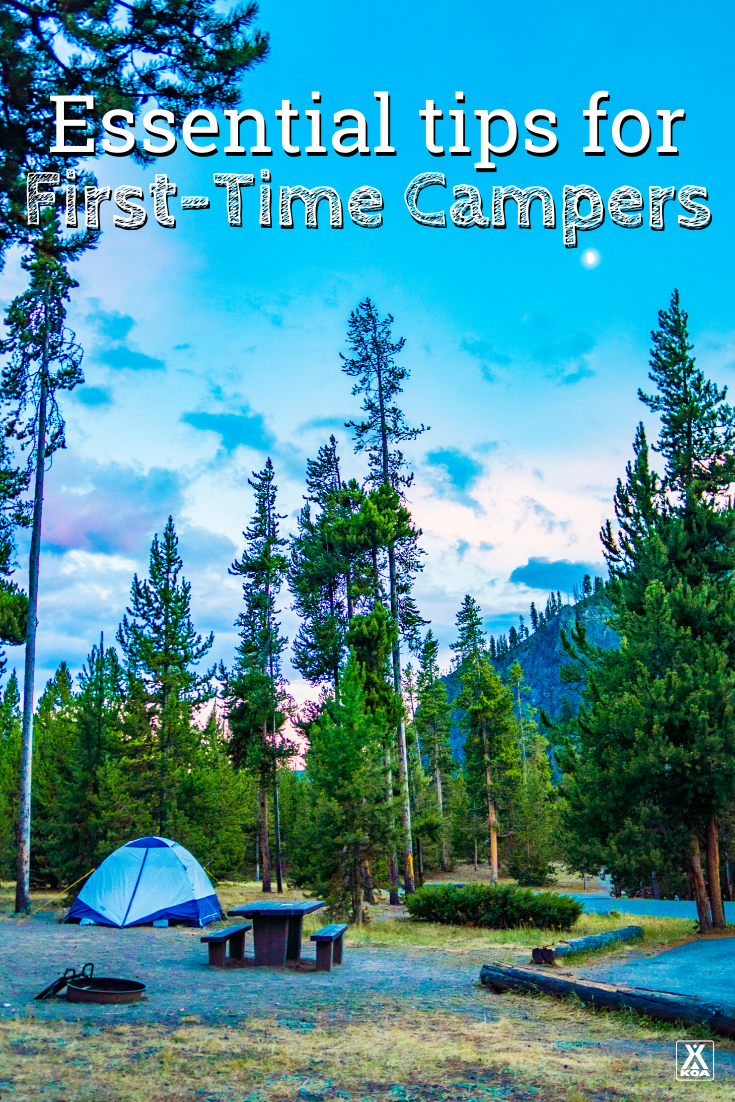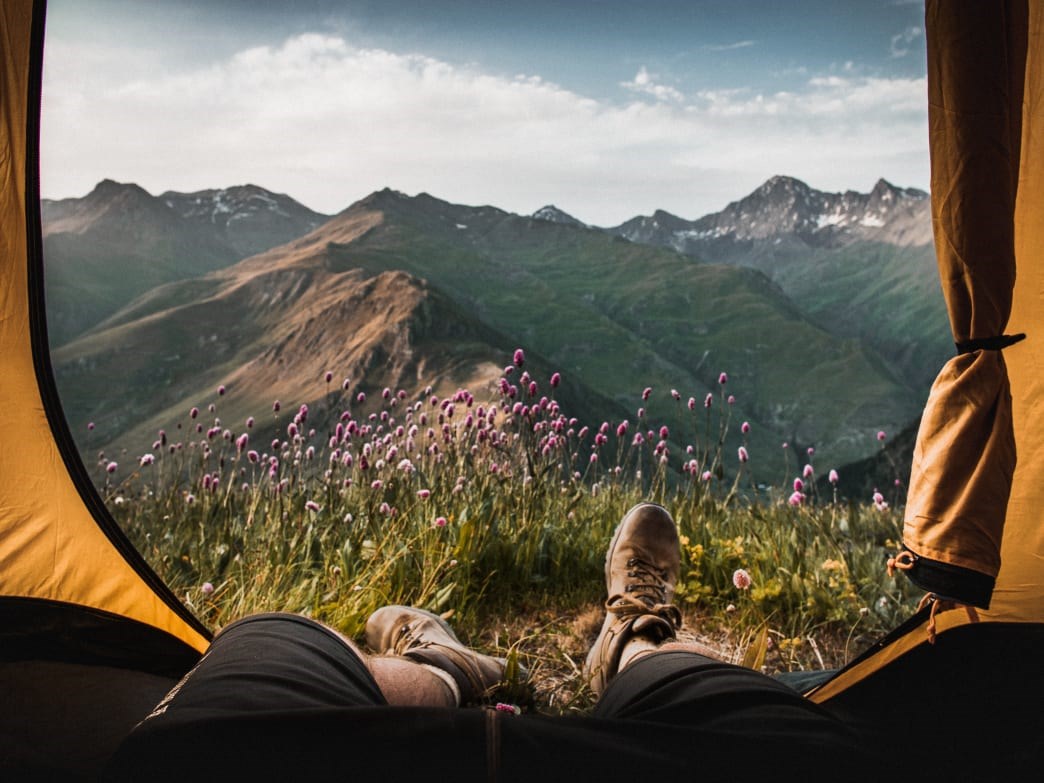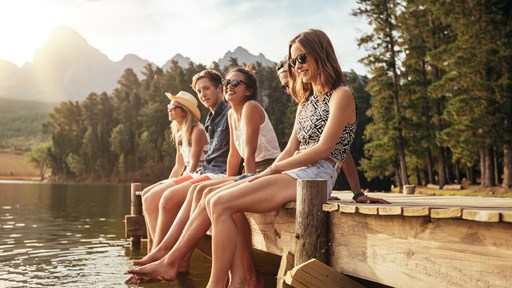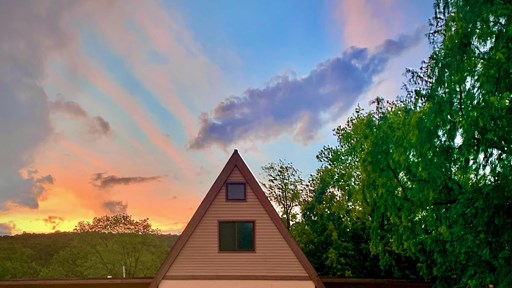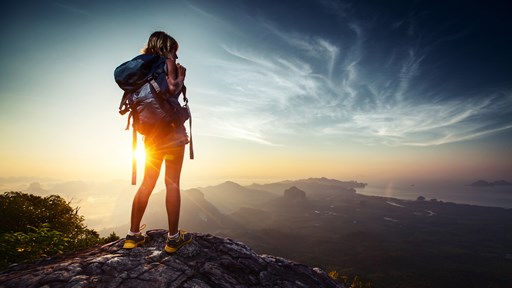The idea of camping can intimidate some people. But the truth is, camping is not only one of the easiest outdoor activities to do, but it’s also one of the most widely-loved. Its simple charms are addictive: crackling fires, fresh air, the exchange of stories with close friends, and all the s’mores your inner-fifth-grader-heart could want. There’s a reason people love camping. It’s surprisingly easy to get started, especially when you go to a KOA campground that’s filled with all the amenities you need. Here are seven things you should know that will help you get started.
1. Types of Camping
When you say “camping,” what exactly does that mean? There’s self-supported backpacking where the camper carries all their gear on their backs for miles on end before setting up camp in the backcountry. There’s dispersed camping, which is basically primitive car-camping in National Forest lands outside of designated campgrounds and there’s traditional campground tent camping where you use your car to carry and store most of your supplies and then set up shop in a designated campground. Then there’s the whole supporting cast of RV camping, yurt camping, hammock camping, cabin camping, motorcycle camping, and more.
For this article, let’s focus on the ol’ tried-and-true campground tent camping, which is the traditional form of camping most first-timers would do. This is arguably the best style of camping for beginners because it’s safe and comfortable with a no-pressure environment for learning how it all works.
2. Essential Gear

Peter Vanosdall
The most foreign concept for first-time campers is the gear, so let’s boil it down: The good news is that, because this is car camping, the equipment has far more leniency in terms of what you can bring. Backcountry camping requires lightweight, high-tech gear that’s generally quite expensive. That’s not the case with car camping. In a campground, you can get away with heavier, more spacious items—plus a lot more creature comforts. Here’s what you’ll want:
- Tent: The size of your tent depends on how many people are in your group and how much privacy you want. If you’re looking for family bonding with the little ones, maybe opt for a 4-person tent. If the little ones aren’t so little anymore and they’re itching for independence, it might be a good idea to succumb to two 2-person tents.
- Sleeping bag: With campground car camping, you have more room to experiment with inexpensive options here. But if you envision camping becoming a frequent hobby, it might make sense to invest in quality here. Down is a lightweight and warm—and there are plenty of synthetic options out there that work better than the somewhat cheap flannel options in the department stores. Shoot for a multi-season, 15-30 degrees bag. (A 15-degree bag means that the average sleeper would remain comfortable and warm unless the temperature dropped below 15 degrees.)
- Sleeping pad: It can be foam. It can be a lightweight air pad that you manually blow up like a balloon. Whatever it is, make sure to have one. They’re more than just your back’s best friend; they’re insulators from the cold ground below.
- Kitchenware: This somewhat depends on your camp food preferences. Are you “America’s Next Top Camp Chef”? Or are you OK with the simpler staples like granola, oatmeal, ramen, and summer sausage? Whatever it is, you’ll generally want a camp stove, pots and pans, plates and cups, and utensils.
- Lighting: Camp lanterns are great for group settings, especially if you all want to gather ’round a picnic table for a game of cards or a communal meal. Headlamps are vital for pretty much every other task around camp, from zipping up zippers to scrounging around for late-night snacks to reading before sleep.
- Extras: Ahh, the beauty of car camping. This is where you can get creative and comfortable. Bring a cooler stashed with snacks and drinks. Bring a hammock to lounge in during the day. Bring some camp chairs if logs just don’t quite cut it. Remember, the car is only about four feet away. So, whatever you feel will enhance the experience, you’ve got leeway.
3. What to Wear

Nathan Dumlao
Even with the safety net of a car, it’s wise to make a few conscientious clothing decisions. It’s best to leave all-cotton clothing at home and opt for synthetic apparel or wool instead. Cotton has a nasty habit of not drying all that quickly, and it’s a terrible insulator. Fleece, down, wool, and other synthetic fibers are better options for staying warm and dry. Think about the possible weather conditions and plan for the worst. Dress in layers so it’s easy to adjust to the temperature. With socks, you can never have too many. They’re warm, comfy, cozy, and great. Bring extras.
4. What to Eat
Food is a big one. It’s also maybe the most enjoyable one. Because let’s face it: While nature is nice, and getting away from the everyday stresses of the modern world is a worthy motive, the main reason we like camping is because of this universal truth: Everything tastes better in the woods. In the woods, a regular old pepperoni roll somehow tastes as if it came from a Michelin-starred restaurant. With car camping, there are a couple of options. You can bring a small camp stove and keep it simple with staples like noodles, couscous, rolled oats, mashed potatoes, mac n cheese, and so on. Or, if you’re feeling adventurous, you can use your campsite’s fire ring as your very own outdoor oven, using tin foil to wrap up as many vegetables and meats as your heart desires to make campfire “hobo packs.” The options are near-endless. (Here are some easy and tasty recipes to get you started.)
5.What to Do

OK, maybe you’re the type of person who wants to go camping because it’s a chance to do positively nothing but stare deeply and silently into a campfire for three days straight—more power to you. But if you like to mix up your fire-staring with a little fun and games, then you’re in luck. That’s one of the best aspects of camping.
This is the woods we’re talking about—a place where you’re free to let loose and get creative. You don’t have the easy entertainment of a TV screen or smartphone (though if you do need WiFi, KOA’s got you covered, don’t worry). If you’re camping with kids, lean into their imaginations. Give them the freedom to come up with the activities. Invent games. Tell stories. Whip out the miniature chess or checkers set or deck of cards. Sometimes, simple fun is the best fun. And if that still doesn’t cut it, lucky for you, many KOA campgrounds feature a whole slew of fun-filled amenities like miniature golf, swimming pools, and more.
6. Watch the Weather
If you’re a first-timer, our advice is to plan ahead as much as possible. Obviously, there’s a big asterisk here; weather tends to have a mind of its own and certainly has a weird, twisted hobby of toying with meteorologists. There’s not much that’ll turn first-time campers into only-time campers faster than a cold, pounding rain or subfreezing temperatures. Save these weather experiences for when you’re a more experienced camper. Until then, consider your camping destination’s seasonal weather. If it’s the Mountain West in summer, be prepared for afternoon thunderstorms. If it’s the Southeast, there will be bugs. The shoulder seasons of autumn and spring are generally the most desirable camping conditions, but again, some regions have very different definitions of what months these seasons are.
7. Be Respectful
Lastly, camping is amazing. But camping can very quickly be ruined if there are a few bad apples who fail to follow campground rules and Leave No Trace principles. The good news is that it’s incredibly easy not to be a bad apple. Clean up after yourself, pack out what you bring in, and don’t be too rowdy with your group (especially once the sun goes down). Simple things, but very important ones to preserve campgrounds as the serene nature havens that they are.
Ready to give it a try? Find a KOA near you to get started today!? You’ll find that people around you are more than happy to help answer any questions you have to help you discover the joys of the experience.
Written by Ry Glover for Matcha in partnership with Kampgrounds of America.
